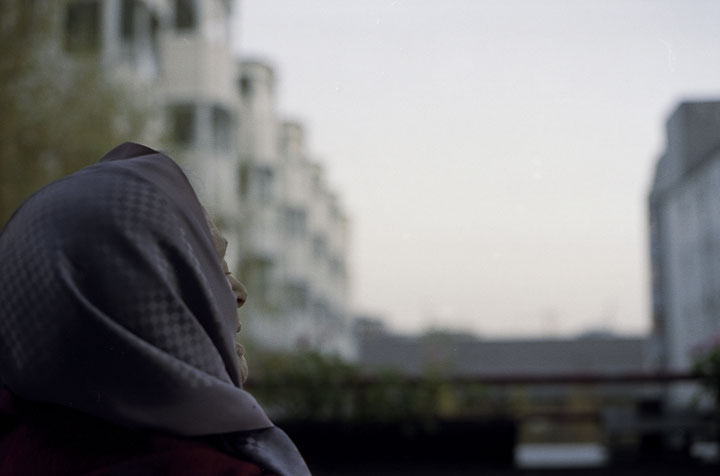Issue 2/2007 - Leben/Überleben
Why Take a Look at Dying?
The documentary films »Zeit des Abschieds/Time of Closure« and »Zeit zu gehen«
[b]dying / is an art, like everything else[/b]1
One hour long. The documentary film »Time of Closure« by Mehdi Sahebi portrays the final months of Giuseppe Tommasi, who is terminally ill with cancer. The film focuses on his physical and mental processes as he dies in a hospice in Zurich. The motivation and impetus behind this film project were part of his desire »to create order and look at the whole thing before I have to go« as well as to understand the »mechanisms that were at work«. Giusi is in his mid-forties, has been a junkie for years, is HIV-positive and has incurable cancer.
Mehdi Sahebi, a documentary filmmaker and cameraman who was born in Iran in 1963 and has lived in Switzerland since 1983, already knew Tommasi in the time before his addiction and before he became homeless because of it. During the nine months it took to shoot the film, their casual acquaintanceship grew into a friendship.2 What has resulted is the visual testimony to Giuseppe Tommasi’s attempt »not to die as a junkie, but as a father.« We see visits from his two children; attempts to discuss early traumas »frankly and honestly«; a last visit to a junkies’ centre; a birthday party at the hospice. Giusi’s skin is covered with marks – traces of the painful procedures of radiation therapy.
The film remains strangely remote from any kind of exhibitionism, protects its protagonist and follows the metaphor of »understanding as seeing«,3 which determines both its dramaturgy and the both economical and emotional precision of the editing.4 The editing (carried out by Mehdi Sahebi and Aya Domenig) gives dramaturgic weight to the chronology of events: the documentation begins with a filmed telephone call in which a hospice worker informs family members of the death or the time of death; then the corpse is prepared, burial equipment, the removal of the coffin and the procedure of cremation. The facticity of the corpse stands in the way of any sentimental build-up of tension.
Is there any evidence of the affection with which Mehdi Sahebi accompanies his acquaintance and friend Giuseppe Tommasi in his dying months? Perhaps this empathy on the part of the filmmaker can be felt in the way his protagonist, looking back and reflecting, incessantly talks for himself and into the camera, and in the fact that there is no advice given or attempt made to address the hospice or the medical measures as an institution, as a place. The focus is on the dying man. Being-there (Dasein) – says Heidegger – as essential being-towards-death cannot take away the Other’s own death, but can care for the death of the Other – says Lévinas – and make the process of dying recognisable as a last living experience. This care becomes a chance of confronting the taboo of showing dying.
[b]»Recording death as it occurs and preserving it for ever – that’s something only cameras can do.«[/b]5
For the dying man, the conversations (or monologues) »about the last things« are above all conversations with his children, clarifying relationships, barely any sombre emotions. His death throes are alleviated by constant doses of methadone, pain killers and opiates. In the end he dies in front of the camera, mourned over by the hospice carers.
The modern hospice movement is only 40 years old: in 1967, St. Christopher’s Hospice in London opened under the direction of the doctor and hospice pioneer Cicely Saunders. Even today, concepts of palliative medicine for the last phase of life are oriented towards effectively combating pain while allowing the patient to remain as aware as possible. Physical pain6 is not to lead to unnecessary suffering for the dying person; instead, symptoms are controlled, so that he or she can come to terms with the process of dying.
The Austrian documentary »Zeit zu gehen« (»Time to Go«) by Anita Natmessnig was made in six weeks at the Caritas Socialis hospice on Rennweg in Vienna and shows the everyday life of several dying people in the last weeks of their life. Even if wooden beds instead of hospital beds are standard here, this film conveys an impression of the hospice as a place of incessant chores, the dominant physiology of the dying body. Death remains an unavoidable, discreetly negotiated fact that is familiar and is confronted stoically, sometimes even a little casually. In an atmosphere of general, universal friendliness, every dying person has »his/her own dilemma« that is noted with mild objectivity, but it always remains the fate of the others, their decline, their living of the illness cancer to its end.
While Sahebi takes over the direction, camera, sound and editing himself, Natmessnig filmed with a team. In the places where she aims to convey the impression of »staying power« with long shots in which little occurs, an emotionalising, symbolic ease redolent of television reports gets in her way. Proving the humanity of an institution in the end remains a hopeless endeavour. One can feel that this attempt to distance herself by using a rhetorical structure offers her a refuge where she can ward off her own horror at death.
Why look at dying at all? Dying a non-violent death is something that is disappearing more and more from view. There is an increasing hospitalisation of dying and fear of contamination, or, as Philippe Ariès writes: »The rejection of death has extended beyond the affected person and the expression of grief to include everything that is involved with death and is infected by it. Grief, or that which resembles it, is seen today almost as a contagious disease that can be contracted in the room of a dying or dead person.«7
Translated by Timothy Jones
1 Sylvia Plath, Lady Lazarus, 1962.
2 In this connection, see Michel de Montaigne, On Friendship: »What we usually call friends and friendship is at the most close acquaintance, either made in certain circumstances or for some advantage, and that only connects us to this extent.«
3 George Lakoff & Mark Johnson, Metaphors We Live By, Chicago 1980, p. 48: »Understanding is seeing.«
4 »Time of Closure« was shown at the 2006 Locarno film festival as one of seven selected films during the Semaine de la Critique, and the Viennale film festival.
5 Susan Sontag, Regarding the Pain of Others, Farrar, Straus and Giroux, 2002
6 See Elaine Scarry, The Body in Pain. The Making and Unmaking of the World, New York 1985.
7 Philippe Ariès,The Hour of Our Death, translated by Helen Weaver. New York: Alfred A. Knopf, 1981
»Zeit des Abschieds/Time of Closure«, Director: Mehdi Sahebi, Switzerland 2006, www.cineworx.ch
»Zeit zu gehen«, Director: Anita Natmessnig, Austria 2006, www.zeitzugehen.at
St. Christopher’s Hospice: www.stchristophers.org.uk



